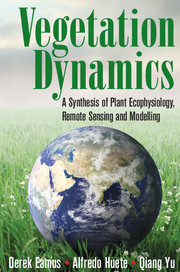Book contents
- Frontmatter
- Contents
- Preface
- Section One Plant Ecophysiology
- Section Two Remote Sensing
- 4 An Overview of Remote Sensing
- 5 Fundamentals and Physical Principles of Remote Sensing
- 6 Satellite Sensors and Platforms
- 7 Remote Sensing of Landscape Biophysical Properties
- Section Three Modelling
- Section Four Case Studies
- Index
- References
5 - Fundamentals and Physical Principles of Remote Sensing
from Section Two - Remote Sensing
Published online by Cambridge University Press: 05 June 2016
- Frontmatter
- Contents
- Preface
- Section One Plant Ecophysiology
- Section Two Remote Sensing
- 4 An Overview of Remote Sensing
- 5 Fundamentals and Physical Principles of Remote Sensing
- 6 Satellite Sensors and Platforms
- 7 Remote Sensing of Landscape Biophysical Properties
- Section Three Modelling
- Section Four Case Studies
- Index
- References
Summary
An understanding of the physical principles of how electromagnetic energy interacts with the Earth's surface is essential for accurate interpretations and effective use of remote sensing images and datasets. In this chapter we highlight the main physical processes of radiant energy interactions with the Earth's surface as they relate to satellite measurements and the generation of remote sensing imagery for use in ecology and environmental sciences.
Fundamentals of the Remote Sensing Signal
Remote sensing is defined as the acquisition of information about the biophysical state and condition of the Earth's surface through non-contact, sensor-based observations. The information is transmitted from the surface to the sensor in the form of electromagnetic radiation, providing us the opportunity to detect or ‘sense’ this signal and derive information about the health, structure, and condition of objects on the land surface from afar.
The electromagnetic signal may be solar energy that is reflected from the Earth's surface or it may be emitted energy coming from the Earth's surface itself, irrespective of the presence or absence (night time) of sunlight (Fig. 5.1). Thermal and microwave radiation are two examples of emitted energy commonly measured by remote sensing. In certain cases, the signal received at a sensor may be a combination of solar-reflected and self-emitted energy, which may be useful, for example, in the detection of fires when portions of the shortwave infrared are detected. Alternatively, an ‘active’ sensor system generates the energy that interacts with the Earth's surface, which is then detected by the same sensor system, as in the case of Radar (Radio Detection and Ranging) and Lidar (Light Detection and Ranging) remote sensing (Fig. 5.1).
Regardless of the type of electromagnetic signal, the energy received and detected by remote sensing provides valuable information that can be used to interpret and characterize the physical, chemical, and biologic state and condition of the surface, along with surface processes involving soils, vegetation, water, and land-use activities. Although, in remote sensing we focus primarily on the measurement and information content of the electromagnetic radiation, this signal may be coupled with other energy terms to yield estimates of evapotranspiration, photosynthesis, and soil moisture content.
- Type
- Chapter
- Information
- Vegetation DynamicsA Synthesis of Plant Ecophysiology, Remote Sensing and Modelling, pp. 167 - 183Publisher: Cambridge University PressPrint publication year: 2016



